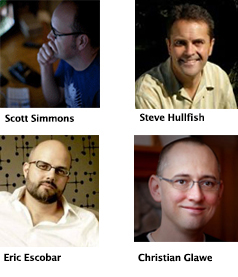 You don’t have to look too far into the PVC archives to find out what Scott Simmons, Bruce Johnson and Kevin P. McAuliffe were up to during NAB 2015. All three of them were in Las Vegas for the annual event, and each of them posted videos along with detailed thoughts and analysis. Scott and Kevin even hosted separate live sessions in the Teradek booth.
You don’t have to look too far into the PVC archives to find out what Scott Simmons, Bruce Johnson and Kevin P. McAuliffe were up to during NAB 2015. All three of them were in Las Vegas for the annual event, and each of them posted videos along with detailed thoughts and analysis. Scott and Kevin even hosted separate live sessions in the Teradek booth.
On the latest installment of the PVC edition of That Studio Show, Scott digs into the details of the event with Bruce and Kevin, and they talk through their thoughts, impressions and insights. The guys discuss the continued drone invasion, whether or not HDR is about to arrive, what they saw at the Adobe and Avid booths plus some predictions around what we might see next year and plenty more.
Below is a partial transcript of that conversation. To listen to the whole thing, subscribe or rate the show in iTunes or listen to the show on Stitcher Radio.
Scott: On this ProVideo Coalition version of THAT Studio Show, I talk with Bruce Johnson and Kevin P. McAuliffe. We all attended NAB 2015 so we chat a little bit about our experiences there. What we saw, what we didn’t see and what we might see next year. We chat, of course, about drones, Adobe and Avid, a little bit about Blackmagic and all their cameras, some other camera manufactures and what was introduced. We chat a little bit about shared storage and look at some of the other products and other cool things that we saw at NAB 2015. We speculate a bit on the future, how for any one technology that comes out these days, you’ve got five or six different options of manufactures of that same technology. It’s a good chat, so let’s get started.
Today I’m joined by Bruce Johnson and Kevin P. McAuliffe, and we’re talking NAB 2015. All three of us were there, covering and working the event, and doing all kinds of fun stuff. Bruce, give us a little bit of background around you real fast before we start talking all things NAB.
Bruce: I’m an old guy. I like to say I’ve been continuously employed in broadcast television for over 33 years now. I’ve seen a lot of change in that time. I’ve worked in commercial, public TV and also in freelance and business as well. So I get to play with a lot of different stuff.
Scott: Are you freelance now? Or are you on staff somewhere?
Bruce: I’m with Wisconsin Public Television but I still freelance as well. I have my own company called Painted Post Multimedia.
Scott: And you are a PC guy, as some of your articles and review on PVC are PC related, so you’re one of the few.
Bruce: I think I’m the only PC guy, honestly.
Scott: And Kevin, you are up in Toronto, Canada, and you’re a post guy. I think of Bruce as more of a production guy, but you actually do post as well.
Bruce: I’m a utility infielder. I’m an ENG shooter, I do documentaries, I work in the studio, I work on trucks. My day job right now is shooting multi-camera stuff on remote. So, whatever works.
Scott: And Kevin, what about you? You’re a post guy, and I know you used to do a podcast called The Post Corner.
Kevin: I used to do that podcast, but I became too darn busy with everything that’s going on. For the day job, I’m one of the senior editors at Extreme Reach in Toronto. Extreme Reach is one of the biggest spot delivery services in North America. We have the big studios calling us because we have to ability to make necessary changes. Obviously when they’re going to air their commercials in Canada, we don’t have the same rating system as the US and we use the Queen’s English up here so a lot of the spellings have to be altered. We have the ability to take these commercials and in a short amount of time, adjust them for Canadian television and get them out on the air. For us, Spanish isn’t the second language, French is the second language, so a lot of the spots we do for the studios we’ll have to do in French. A lot of the times the direction we’re given is, “see the way that works in English…do the exact same thing in French.” Except we’re not given any elements except for split audio elements. So we basically have to recreate the spots, almost like reverse engineering. We look at a spot and make a guess about it being Video Copilot, or an effect being GenArts or whatever else. We have to rebuild these spots as needed to make it look like they were made like that from scratch.
Scott: You do a lot of GenArts and effecty stuff in Media Composer, and god bless you for being able do do a lot of effects in Media Composer.
Kevin: I try to tell people, stay in there as much as you can. Don’t get me wrong, I love After Effects, but stay in your timeline as much as you can.
Scott: I agree totally.
Bruce: I should probably throw in right now that I’m an Adobe Influencer, so you and I ought to talk later on.
Kevin: There you go.
Scott: We’ll talk about Adobe, but first, you can’t talk NAB without talking about drones, because god knows those things were everywhere. I don’t know if either of you guys have drone experience, but what were your thoughts, not just about the abundance of drones, but the space they were taking up and how they were flying around. They were everywhere.
Bruce: It was a little disconcerting. The very first time I went to NAB was when I was a junior in college in 1979, and all the big names were there. RCA and Harris, and even Panasonic, but it never looked like a hobby tradeshow before, but that’s been building up for a couple years now. I have a drone…and I hate the term drone. I am an RPV pilot, I have a Phantom 1 with a GoPro hanging off the bottom and the money I spent on that and the gimbal I stuck on the bottom is less than it costs now to get a Phantom 3 with down link video and a much better gimbal and a pretty good camera. It’s a little bit spooky. Having said that, I should be expecting that, because with Moore’s Law, all of it is just another iteration. It really bothered me to a very large extent that in the Drone Pavilion, which was in the upstairs of the south hall, there was a guy talking about the “gold rush” in aerial videography, and they had a big booth there called “The Gold Rush” booth. And I thought to myself that back in the real Gold Rush days of 1849, the only people who made any money were the people who sold the shovels. Most of the people who went out to try and strike gold came back with nothing. Having said that, until there are some real solid rules in place for this stuff to be operated, I don’t know what the future holds. The other thing that I’ve been telling people all along is that it’s only going to take one of these things getting sucked into the intake of a regional jet and it’ll all be over with.
Scott: Oh boy, yeah. That’s the thing. You’re waiting for that one big accident to happen via some drone pilot not being careful. I mean, I think that there’s a lot of discussion. The FAA was there for a panel, and PVC’s Jeff Foster was one of the main guys behind the Drone Pavilion, and I think it was very successful as they had a lot of traffic where they setup in the back of south hall. I do think it’s totally the Wild West. Bruce, you mentioned hobbyists, but does it kind of have that feel? It felt like three or four of the main central hall drone companies were just little plastic GoPro things as opposed to the more higher end ones that could carry the new Blackmagic camera or the RED Epic or something. They felt very plasticy and toyish.
Bruce: Well, that’s true. But by the same token, in the world that I work in, commercial TV, a GoPro will get you 90% of what you want. My station, which is public television, just spent…
Scott: But if you have a choice, you’re going to want a better image than what’s going to come out of a GoPro, right?
Bruce: If you have a choice. But let’s face it, if you have a Phantom and a GoPro, you can get up and down in five minutes. If you have an octocopter that’s carrying around RED Epic, and you have to have two pilots and people scouting for you and stuff like that, it’s a much bigger endeavor. And the fact is, there’s really no settled rules right now, and I’ve never heard anybody get arrested for doing this, but once again it’s going to take a big accident for this to happen and everyone’s antenna is going to be up and it will be a whole different world. I respect the guys who have gone forward with this thing but the FAA and FCC’s lag time around this is pretty indefensible. And then there’s the Gold Rush mentality which makes everyone think they need to get in and get out before it all blows up, which is a terrible and dangerous attitude. People think it’s just a four pound piece of plastic, but if you put a four point piece of plastic with rotating blades at two hundred feet, it’s going pretty fast by the time it hits the ground and it could kill someone.
Scott: The jet engine comment is the best, because we’ve seen birds get sucked into the intake of engines and cause problems, and the drones would cause serious problems too. Kevin, as a post guy, any thoughts on drones? My thing is that I get some nice footage that comes from them, but that’s the only way it affects me.
Kevin: I took a walk up there because I was curious, and to be perfectly honest, I wasn’t quite sure what I was supposed to be looking for. I saw they had a golf dome setup, and then I realized that was where they had all the drones flying. I guess just in case one of them got out of control and they were going to have to shoot it down or something. One thing that I found kind of interesting is that for me, if I was going to get into the drone market, my problem is that I know the big names and I wouldn’t even know where to begin. I just saw that the person who either was in Roomba or started Roomba, they sort of have their own… it’s not the Roomba version of a drone coming out, but it has a lot of the ideas. It’s got the invisible walls that you can just have your drone fly around inside of. For me, because drones have sort of become the big thing, now it’s going to be a matter of differentiation between these companies so that someone who’s coming to this new is going to know which one would be a good one to buy. I saw how many there are. There are so many companies that I wouldn’t even know where to begin, so what they need to start doing is educating people like me who don’t know anything about it in terms of where’s a good place to start, what do I need to start looking for if I want to buy one of these, what’s a good entry price to start at, etc.
Scott: Think of all the different cameras out there, and they each have strengths and weaknesses. Maybe we could have a drone markets like that where there are 10 or 12 available from different manufacturers and one does that particular thing better than the other one. I guess that kind of makes sense.
Bruce: Well, not really. What you’re talking about is stable 3D motion, and if you can do it, you can do it. On the other hand, you have the new helicopters like the Phantom 3 which has a built in DJI branded camera, and it’s not quite the known quality that GoPro is. There’s a video out there that Adam Savage of MythBusters did on their tested.com website where he flys the slightly larger version of the Phantom. It’s called the Inspire 1. If you want to look that up, it’s kind of interesting. It’s pretty impressive what this thing can do. If you’re looking for the brand name that has the first mover advantage…the Avid of the drone world these days is definitely DJI.
Scott: Isn’t that kind of the thing now? They’re all going to fly with four blades and carry a GoPro, that’s pretty common. But isn’t the innovation going to be in the software, and what manufactures can do? How it can interact with you phone and what kind of GPS stuff it can do? Stuff with motion control?
That’s just a preview of what Scott, Bruce and Kevin discussed during the podcast. Hear the rest about what the guys have to say around Adobe, Avid, the future of NAB and plenty more via the links below.
Subscribe or rate the show in iTunes
Listen to the show on Stitcher Radio!

Filmtools
Filmmakers go-to destination for pre-production, production & post production equipment!
Shop Now













